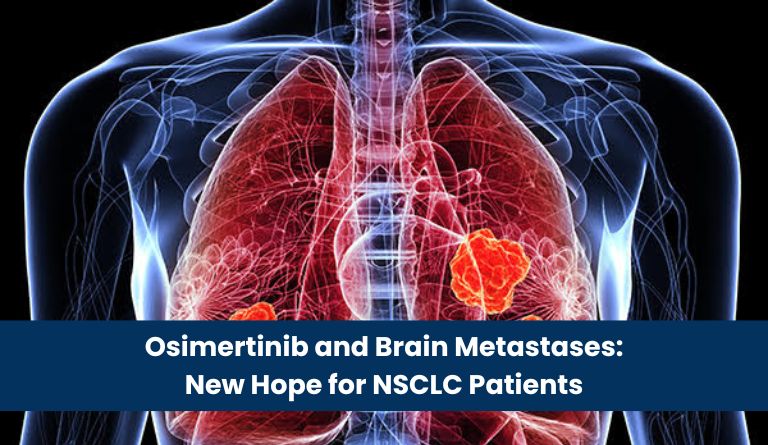It is complicated enough to become a patient of Non-Small Cell Lung Cancer (NSCLC). It may be disabling to learn that the cancer has spread to the brain, a condition called brain metastases. It adds a very tricky dimension to treatment, as it requires therapeutic methods that can penetrate deeply into this haven. Fortunately, major advancements in target therapy, especially with such drugs as osimertinib, are providing a new ray of hope.
Now, let’s explore why Osimertinib is becoming an increasingly important tool in the treatment of NSCLC, particularly in cases where the disease has already metastasised to the brain.
Understanding Brain Metastases in NSCLC
The brain is a common site for NSCLC to spread, largely because traditional chemotherapy drugs often struggle to cross the blood-brain barrier, a natural protective shield. This barrier, while essential for brain health, can unfortunately prevent many cancer drugs from reaching the tumour effectively. Brain metastases can cause symptoms such as headaches, seizures, vision problems, or cognitive changes, which significantly impact quality of life. Managing these requires treatments specifically designed to penetrate this barrier and target the cancer cells residing within the brain tissue. This is where the unique properties of Osimertinib become particularly important.
What Is Osimertinib?
Osimertinib belongs to a class of drugs called EGFR tyrosine kinase inhibitors (TKIs). It’s specifically designed to target lung cancers driven by mutations in the EGFR (Epidermal Growth Factor Receptor) gene – a common driver in a significant subset of NSCLC patients, particularly in certain populations. What makes Osimertinib stand out, beyond its primary mechanism, is its impressive ability to cross the blood-brain barrier effectively. This characteristic is pivotal for its success against Osimertinib brain metastases.
As a highly specialised medication, the quality and purity of the Osimertinib API (Active Pharmaceutical Ingredient) are paramount. Reliable active pharmaceutical ingredient manufacturers ensure this critical starting material meets stringent global standards, forming the foundation of the final medication’s safety and efficacy. Companies specialising in API manufacturing, particularly for complex oncology drugs like Osimertinib, play a vital role in the overall treatment journey.
Why Osimertinib Matters in Brain Metastases
The true significance of Osimertinib shines brightest in the context of Osimertinib brain metastases. Its superior penetration into the central nervous system (CNS) translates directly into clinical benefits for patients:
- Effective Tumour Control: Studies consistently show that Osimertinib achieves high response rates within the brain, meaning it can shrink or stabilise brain metastases effectively in many patients with EGFR-mutant NSCLC.
- Delaying Progression: It significantly delays the time it takes for brain metastases to worsen compared to older therapies, offering patients longer periods of stability.
- Potentially Delaying Radiation: For some patients with smaller or asymptomatic brain metastases, starting Osimertinib upfront might effectively control the disease in the brain, potentially postponing or even avoiding the need for immediate whole-brain radiation or stereotactic radiosurgery (SRS) and its associated side effects.
- Systemic Control: Crucially, it simultaneously controls the cancer elsewhere in the body, providing a comprehensive treatment approach.
This dual-action, potent systemic control coupled with robust brain activity makes Osimertinib a cornerstone of EGFR lung cancer treatment for eligible patients, especially when brain involvement is present or a significant risk.
Osimertinib vs. Other EGFR Inhibitors
Earlier generations of EGFR TKIs (such as gefitinib, erlotinib, and afatinib) revolutionised EGFR lung cancer treatment and remain valuable tools. However, they generally have more limited penetration into the brain compared to Osimertinib. While they offer systemic control, their effectiveness against established brain metastases was often less robust.
Furthermore, Osimertinib was specifically developed to target the T790M resistance mutation, which frequently emerges in patients treated with first-line EGFR TKIs. This gives osimertinib a distinct advantage both as a first-line option and as a subsequent therapy after resistance develops to older drugs. Its superior CNS activity is an added, critical benefit distinguishing it within the Osimertinib NSCLC treatment landscape.
Side Effects and Considerations
Like all medications, Osimertinib can cause side effects. It’s generally well-tolerated, but common ones can include:
- Skin rash or dry skin
- Diarrhea
- Nail changes (like inflammation or tenderness around the nail bed)
- Fatigue
- Mouth sores
- Less commonly, it can affect the heart (QTc prolongation) or cause lung inflammation (interstitial lung disease – ILD), which requires immediate medical attention.
It’s important to discuss all potential side effects thoroughly with your oncologist. They will closely monitor you and manage any side effects that arise, adjusting the dose as necessary. Never hesitate to report any new or worsening symptoms promptly. Remember, the goal is effective cancer control with the best possible quality of life.
Partnering for Progress: Bulat Pharmaceutical’s Commitment to Quality
The development of Osimertinib represents a major leap forward, especially for EGFR-mutant NSCLC patients facing the daunting challenge of brain metastases. Its ability to cross the blood-brain barrier properly and target cancer cells within the CNS offers tangible hope – better control of brain disease, prolonged periods without progression, and a powerful systemic treatment all in one. For eligible patients, it has become an essential component of modern Osimertinib treatment for NSCLC.
This progress hinges not only on scientific discovery but also on the intricate process of reliably producing high-quality medication. Rigorous pharmaceutical manufacturing standards are non-negotiable. The journey starts with sourcing pure API raw material from trusted suppliers. Leading active pharmaceutical ingredient companies and specialised pharmaceutical ingredients manufacturers are responsible for the complex synthesis and stringent quality control of the Osimertinib API. API manufacturer expertise in api manufacturing processes impacts the consistency and efficacy of the final drug product that reaches patients. Companies like Bulat Pharmaceutical, dedicated to excellence in API manufacturing, play a vital role in this critical supply chain, contributing to the availability of essential oncology treatments, such as Osimertinib.
While the journey with NSCLC, especially with brain involvement, remains complex, therapies like Osimertinib provide powerful tools. They underscore the importance of precision medicine and offer significant hope for improved outcomes and quality of life. If you or a loved one is navigating this path, ongoing conversations with your oncology team about the most appropriate treatment options, including the potential role of Osimertinib, are key.






